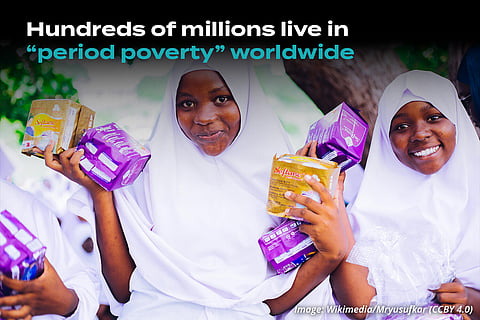Bridging the Gap - Health Equity for all
Menstrual Health Is Public Health. That Means It’s Everyone’s Business.
<p>We take a lot for granted living in a well-developed nation, not least the ease of access to menstrual hygiene products and healthcare. Despite being a natural and vital biological process, menstruation is subject to intense stigmatization and misinformation along with inadequate resources across many parts of the world. </p>
<p>Addressing these challenges is one of the central tenets of promoting gender equality and improving health outcomes for women globally. </p>
<h2>Menstrual health challenges</h2>
<h3>Stigma and cultural taboos</h3>
<p>Shame and secrecy are synonymous with menstruation in many cultures. It might be natural, but menstruation is viewed as unclean, leading to discriminatory attitudes and practices; for example, women and girls may be left out of everyday activities like attending school, cooking, or even interacting with family during the menstrual cycle. </p>
<p>This stigma can have terrible effects on people’s mental health, fostering a sense of shame and poor self-esteem.</p>
<h3>Lack of education</h3>
<p>Acting on your health requires understanding, and understanding requires education. Many young people do not receive adequate information about menstruation before they get their first period and are effectively blindsided by it.</p>
<p>The lack of knowledge triggers confusion, fear, and an inability to manage menstruation effectively. Educational programs need to be inclusive, culturally sensitive, and accessible to all genders to foster a supportive environment.</p>
<p>A joint report from UNICEF and the WHO found that, globally, only 2 in 5 schools provide menstrual health education. In regions like sub-Saharan Africa, only 1 in 8 schools were found to provide products, whether for free or for purchase.</p>
<h3>Poor access to menstrual products</h3>
<p>Whether you need one in a pinch or are stocking up for a long time, tampons, pads, and more are readily available to women in the West. In other parts of the world, they’re either prohibitively expensive or simply unavailable. </p>
<figure><img src="https://cdn.storymd.com/optimized/OoYP96fMAG/original.jpg" alt width="698" height="392" />
<figcaption>Menstruation Source: TheVisualMD</figcaption>
</figure>
<p>Without this supply, women in these parts are forced to use poor substitutes like rags, leaves, and even newspapers as makeshift tampons. These are unsanitary materials that increase the risk of infections. We must expand efforts to provide free or subsidized menstrual products so that all women and girls can effectively manage their menstrual health and hygiene.</p>
<h3>Insufficient sanitation facilities</h3>
<p>Even when menstrual products are available, inadequate sanitation facilities can pose significant challenges. Schools and workplaces often lack clean and private restrooms equipped with water, soap, and waste disposal options. </p>
<p>This shortcoming drives absenteeism from school or work, affecting educational and economic opportunities. Investing in proper sanitation infrastructure is essential to support menstrual health.</p>
<h3>Health issues and medical care</h3>
<p>Menstruation isn’t always straightforward, and disorders can crop up like dysmenorrhea (painful periods) or menorrhagia (heavy bleeding). Conditions like endometriosis and polycystic ovary syndrome (PCOS) can severely impact a person’s quality of life. </p>
<p>Despite how serious and painful these can be, the stigma surrounding menstruation still forces individuals into silence instead of seeking help. Increased awareness and access to healthcare services are necessary to diagnose and treat menstrual health issues effectively.</p>
<h3>Economic barriers</h3>
<p>Menstruation costs money to manage. People with low incomes can’t always afford menstrual products, never mind the medical expenses and lost wages associated with menstrual health problems. This paints periods as a serious financial burden in some people’s lives, highlighting the need for policy interventions that ensure menstrual equity.</p>
<h3>Environmental concerns</h3>
<p>In terms of the products we use to manage menstruation, there is the prevalent use of non-biodegradable, disposable pads and tampons that hurt the environment. They end up polluting water bodies and landfills, leeching microplastics and causing other hazards.</p>
<p>Sustainable alternatives do exist, with companies selling reusable cups, pads, and biodegradable products that mitigate environmental damage. The upfront costs can be higher than those of regular period products, however, and many people are simply unaware they are available. </p>
<h3>Policy and advocacy</h3>
<p>Concerted efforts from governments, NGOs, and community organizations are needed to tackle menstrual health issues. </p>
<figure><img src="https://cdn.storymd.com/optimized/JdPMvmSjq3/original.jpg" alt width="653" height="435" />
<figcaption>National Training of Trainers on Menstrual Health and Hygiene <em>Source: www.shfund.org</em></figcaption>
</figure>
<p>Through robust policy frameworks and advocacy, we can achieve improved menstrual health education, the availability of free or subsidized products, and proper sanitation facilities. Advocacy is also essential to challenge societal norms and break the stigma associated with menstruation.</p>
<h2>Period poverty in the US</h2>
<p>Some 2 billion people menstruate around the world every month, yet millions of girls and women either cannot afford products or have no access to proper sanitation facilities to manage their menstrual health. This is “period poverty”, and it impacts their lives, rights, and freedoms.</p>
<p>Millions of people cannot afford menstrual products worldwide. Part of the problem is gender-blind policies and tax laws (for example, the so-called “pink tax”) that end up costing women more. In parts of the US, Viagra is considered a tax-exempt health product, and yet tampons are marked as a luxury item with tax charged on top.</p>
<p>Although conditions in the US are still far superior to other regions, 1 in 4 teens and 1 in 3 adults struggle to afford menstrual products in this country. This is particularly acute among Black and Hispanic teens along with lower-income households. </p><h2>More on Menstruation</h2><ul><li><a href="https://soulivity.storymd.com/journal/yj5ddpetnm-menstruation" target="_blank">Menstruation (Period): Phases, Symptoms, Complications</a></li><li><a href="https://soulivity.storymd.com/journal/jbrdanvu2w-menstrual-cycle" target="_blank">Understanding the Menstrual Cycle and How to Track It</a></li><li><a href="https://soulivity.storymd.com/journal/vwdyov7t4w-how-to-use-a-tampon-safely" target="_blank">The Facts on Tampons—and How to Use Them Safely</a></li></ul>


